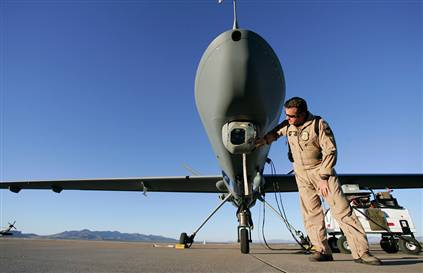Facing a shortage of drone pilots, the US Air Force said Thursday it will increase pay for those who operate the robotic planes and draw on airmen from the reserves to fill the gap.
The growing demand for drones has stretched the American military’s resources and placed a major strain on the aircraft’s pilots, who work an average of about 14 hours a day, six days a week, Air Force Secretary Deborah James told a news conference.
“This is a force that is under significant stress from what is an unrelenting pace of operations,” James said.
Plans to bolster the number of drone pilots come as the United States presses ahead with an air war against the Islamic State group in Iraq and Syria, which has involved daily missions for the robotic aircraft.
The military had expected the need for drone flights to decline slightly with the withdrawal of most troops from Afghanistan. But the US-led air campaign against IS jihadists launched in August has fueled yet more requests for the more than 360 unmanned aircraft in the Air Force fleet, officials said.
“We thought we were drawing down and had a plan in place to man this enterprise that would, if we had actually drawn down, we’d be fine right now,” said General Mark Welsh, the Air Force chief of staff.
An internal memo leaked to The Daily Beast last week quoted a top commander warning that drone operations had reached a crisis point due to the manpower shortage, and that the Air Force would not be able to meet a Pentagon demand for 65 drone combat air patrols this year.
With a large number of the drone pilots approaching the end of their commitment to the military, commanders are anxious to avoid a brain drain and are looking for ways to persuade them to stay in uniform.
“We’ve met the operational demand signal, but we’re doing it by putting people in a position where they’re now having a debate whether they want to continue doing this,” Welsh said.
Looking at pay
The Air Force secretary unveiled what she called “first steps” designed to relieve the pressure on the pilots. But additional measures are being drawn up, possibly including initiatives to be funded in the Pentagon’s budget request to Congress next month.
“We will maximize the use of the National Guard and reserve and indeed, we will be redirecting some resources in order to provide the money to bring additional personnel on active duty,” she said.
Some troops who have been trained as drone pilots but have since moved on to other assignments will be asked to return to the drone mission.
And drone operators who are due to leave for other missions will be ordered to stay on temporarily.
“We’re also looking at pay,” James said.
Drone operators are paid the same rate as conventional pilots, but are not eligible for bonus “incentive” pay offered to persuade airmen to remain in the military as they near the end of their term of service, officials said.
James aims to change that rule but in the meantime, the secretary has approved an increase in the monthly pay for drone pilots whose tenure is about to expire.
The move would hike monthly flight pay from $650 a month to $1,500, according to Welsh.
James said she had visited last year Creech Air Force base in Nevada, a major hub for drone operations, and learned first hand of the strains placed on the pilots.
An average pilot of manned aircraft in the Air Force flies between 200 to 300 hours a year, while drone pilots log 900 to 1,100 flight hours per year, she said.
Welsh said the Air Force also is looking at having enlisted troops fly drones, a practice that the army already has adopted.










